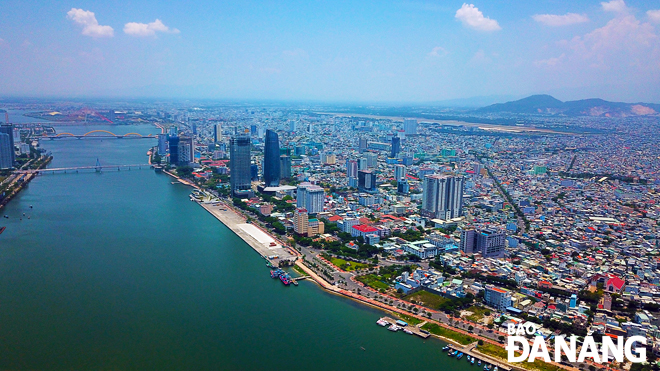Da Nang outlook to 2030 with focus on sustainable urban development
In its strategy 2020-2025, Da Nang will focus on implementing the soon-to-be-approved adjustments to the strategic master plan for major developments in Da Nang to 2030, with a vision to 2045, in a bid to bring up a new aesthetically-appealing and modern facelift to the city in the future.
 |
| Da Nang’s urban hub remains located in downtown Hai Chau District and will be designed to become an architectural highlight with its own identity. |
The strategic plan for shaping the future of Da Nang will be created with a focus on the creation of 3 modern urban areas and one ecological zone, plus 2 so-called ‘economic belts’, namely the northern part boasting high-tech industry and seaport- logistics, and the southern part showing off innovations and high-tech agriculture, Director of the Da Nang Construction Planning Institute Dinh The Vinh said.
In addition, there will be 4 priority job creation clusters, namely the high-tech industrial cluster featuring the Hi-tech and IT parks, the seaport and logistics cluster associated with the soon-to-be-developed Lien Chieu mega-port urban area, the hi-tech agricultural cluster in the southwest hillside area adjacent to Dong Nghe Lake, and the innovation cluster associated with the Da Nang University urban area, a innovation centre and a software park in the southern part of the city.
The city’s tourism cluster will focus on embellishing the east coast and the edge of the Da Nang Bay, and developing cultural heritages, waterway tourism services, and ecotourism in the western and northern mountainous areas and on the Son Tra peninsula in a bid to fully tap the natural landscape and biodiversity potential there.
Meanwhile, the creation of 12 sub-divisions will be included in Da Nang vision to 2030. Prominent amongst them are a downtown location along the eastern bank of the Han River; Lien Chieu Port subdivision, the about high-tech subdivision heading towards hi-tech, environmentally friendly industries and information technology; the ‘Green Core Centre’; the ‘Innovation’ hub featuring the construction of the Da Nang University Urban Area, a software park, international hospitals and Hoa Xuan sports complex; the expanded Da Nang Airport sub-division; plus urban areas in Hoa Hiep Nam Ward and the communes of Hoa Son and Hoa Lien.
Each urban area will comprise of a maximum of 10 residential areas covering a total area of 500 to 1,500 ha and accommodating a combined total of about 50,000 to 250,000 residents.
A comprehensive system of such service facilities as commercial centres, kindergartens, primary and secondary schools, medical clinics, religious establishments public greenery and parking lots must be created in the aforementioned urban areas.
In regard to commerce and finance, heed will be paid to keeping the operation of such traditional markets as Han and Con in association with the Hung Vuong commercial axis.
Likewise, trade centres, supermarkets, specialised shopping streets, convenience stores, central business districts (CBDs) and duty-free shops citywide associated with the development of Vo Nguyen Giap - Truong Sa tourist street.
At the same time, environmentally friendly processing and manufacturing industries, as well as supporting and base industries must be developed to meet the city's environmental protection requirements.
By 2030, Da Nang will find its strategic position in the global supply chain network, reinforcing its position as as a gateway to the East-West Economic Corridor, as well as seek a berth in the ASEAN Smart Cities Network (ASCN) and develop itself into a tourism, service and economic hub inViet Nam in the future.
By TRIEU TUNG –Translated by A.T